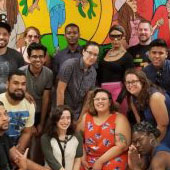RADAR Awarded $13.7 Million to Continue Study of Young Men Who Have Sex with Men, Trans Women, and Nonbinary Individuals
The RADAR study at Northwestern’s Institute for Sexual and Gender Minority Health and Wellbeing (ISGMH) was  recently awarded a $13.7 million, five-year grant from the National Institute on Drug Abuse, part of the NIH. The award will allow RADAR to advance and expand its innovative research on HIV, relationships, and substance use among young men who have sex with men (MSM), transgender women, and nonbinary individuals assigned male at birth in Chicago. ISGMH Director Brian Mustanski, Ph.D., is the project’s principal investigator (PI).
recently awarded a $13.7 million, five-year grant from the National Institute on Drug Abuse, part of the NIH. The award will allow RADAR to advance and expand its innovative research on HIV, relationships, and substance use among young men who have sex with men (MSM), transgender women, and nonbinary individuals assigned male at birth in Chicago. ISGMH Director Brian Mustanski, Ph.D., is the project’s principal investigator (PI).
“There have been very few longitudinal studies of sexual and gender minority (SGM) teens, which are critical to understanding the developmental course of health outcomes as well as identification of risk and protective factors. RADAR is important to the field as the longest running and largest longitudinal study of SGM youth assigned male at birth. At the close of the renewal period, we will have followed some of the participants for nearly 20 years,” says Mustanski.
RADAR involves collaboration across multiple Northwestern University departments. Co-investigators include Richard D’Aquila, M.D., ISGMH affiliate faculty member and professor in the Department of Medicine; Patrick Janulis, Ph.D., ISGMH faculty member and assistant professor in the Department of Medical Social Sciences; Thomas McDade, Ph.D., professor in the Weinberg College of Arts and Sciences and Department of Medical Social Sciences; Michael Newcomb, Ph.D., ISGMH faculty member and assistant professor in the Department of Medical Social Sciences; Sanjiv Shah, M.D., professor in the Department of Medicine; and Harry Taylor, Ph.D., of SUNY Upstate Medical University. Adam Carrico, Ph.D., from the University of Miami is a consultant on the project.
“RADAR is a longitudinal study that examines what factors are important for a variety of individual outcomes related to sexual health, mental health, and social wellbeing over time,” says Project Director Antonia Clifford. “Extending RADAR for an additional five years will allow us to track important sexual health and substance use patterns among young MSM, transgender women, and nonbinary individuals all the way from adolescence through middle adulthood.”
RADAR currently includes 1,200 participants from three separate cohorts recruited between 2008 and 2015. The new funding will support the extended study of these three cohorts, which include participants who now range in age from their early 20s to early 30s, as well as the recruitment of a new cohort of individuals aged 16 to 20.
 RADAR and Howard Brown Health Broadway Youth Center staff.
RADAR and Howard Brown Health Broadway Youth Center staff.
“By following the same group of individuals through this critical period for sexual health, HIV risk, and substance use behaviors, we are able to look at very complex factors impacting the lives of those individuals on a large scale. We can also examine individual, interpersonal, and broader structural perspectives over time. Are things getting better for the communities of people we study? How have historical and political changes like the federal recognition of same-sex marriage or the emerging threat of coronavirus impacted young MSM, transgender women, and nonbinary people? These are all questions RADAR can help us answer,” explains Clifford.
RADAR’s continuation will bring a vital contribution to LGBTQ health research by collecting information on when certain health conditions emerge and risk patterns are established. RADAR is among the only longitudinal studies that will follow young MSM, transgender women, and nonbinary people assigned male at birth in their 30s, a largely unexamined period.
“Extending our research beyond early adulthood lets us track longer term disparities in the health of MSM, transgender women, and nonbinary individuals,” says Clifford. “As individuals move into their 30s, relationships and substance use patterns will begin to solidify, meaning that some relationships will become lifelong partnerships and substance use may transition from higher to lower risk, or vice versa. We also don’t know how and at what point risk factors for chronic issues like heart disease, which severely impact older HIV-positive individuals, begin. By looking at the older RADAR participants over the next five years, we will be able see when those chronic health issues start to appear.”
Because the project will recruit a new cohort with the funding, it will also make possible generational comparisons about the experiences and behaviors of today’s young MSM, transgender women, and nonbinary individuals compared to peers recruited in prior decades. One example is the ability to study changes in racial disparities in HIV rates in Chicago over time. These kinds of findings have the potential to shape future health interventions and programs for LGBTQ youth by providing necessary data to researchers and policymakers.
RADAR’s success depends, in part, on its strong relationships with community organizations, like Center on Halsted, and with participants. The study has a robust participant retention rate over time due to this commitment to individual participants and to being rooted in the communities it serves.
“We honor and value the individuals who participate in RADAR and speak to our interviewers. We create a space where MSM, transgender women, and nonbinary individuals assigned male at birth know they can share their voices, be heard, and have their experiences elevated in ways that make a difference in their communities,” says Clifford.
More information about RADAR, including associated publications and overview can be found here.
Researchers interested in working with data from the RADAR study can access baseline data on cisgender male participants made publicly available on the Inter-University Consortium for Political and Social Research (ICPSR) website. Read more about the RADAR data available through ICPSR here.